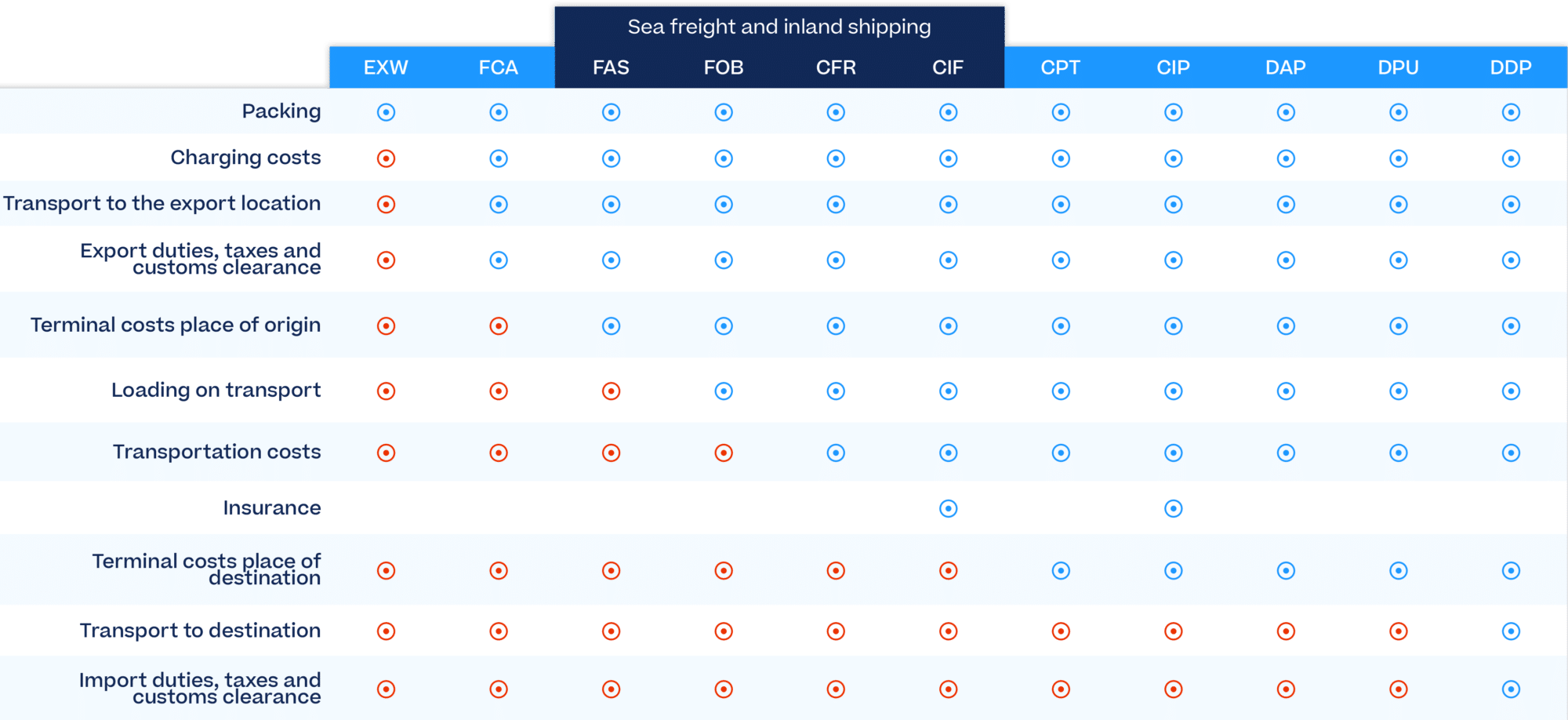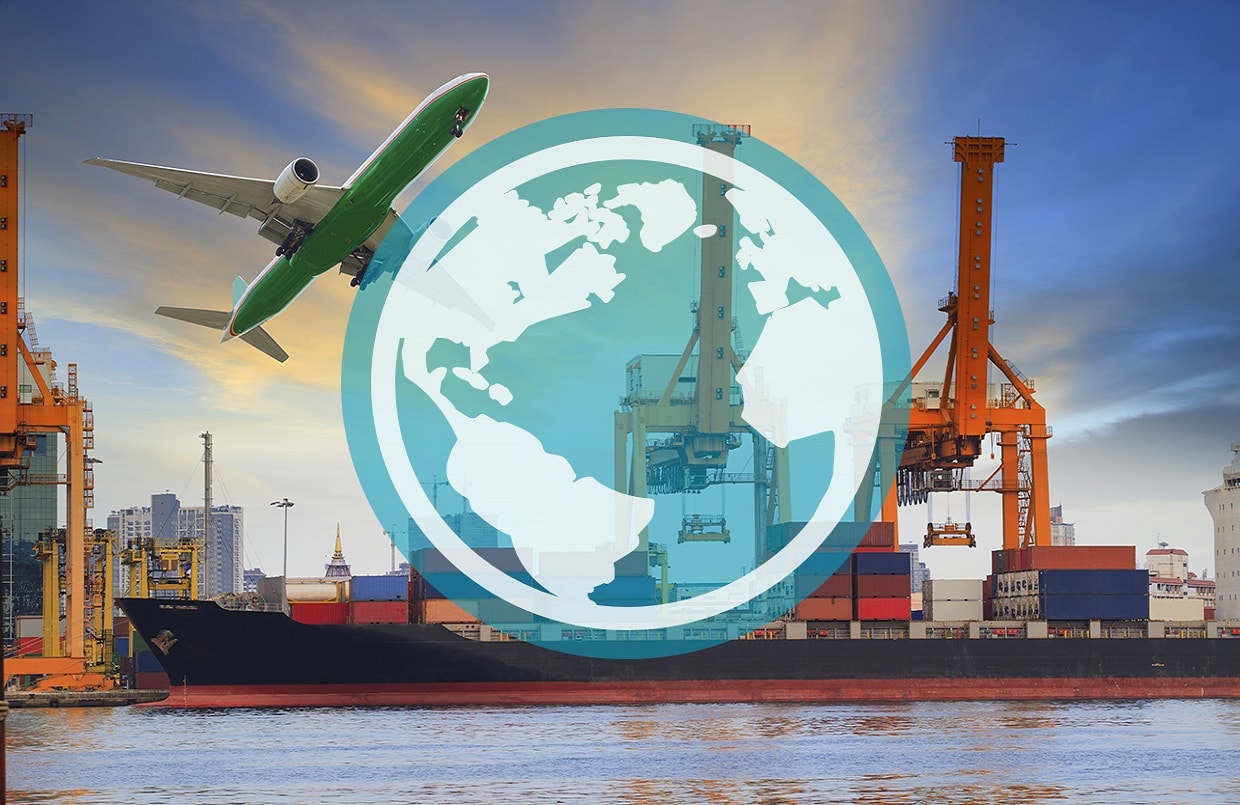Navigating the complexities of international shipping can be daunting, especially when it comes to mastering the Incoterms rules. These internationally recognized trade terms are crucial for defining the responsibilities of buyers and sellers in cross-border transactions. Whether you’re new to e-commerce or looking to refine your logistics strategy, understanding the 11 Incoterms is essential for ensuring smooth and efficient operations.
In this guide, we’ll break down the latest updates from Incoterms, providing clear explanations and practical examples for e-commerce businesses. You’ll learn how to use these trade terms to your advantage, minimize risks, and improve your supply chain efficiency. Ready to become an Incoterms expert and elevate your e-commerce game? Let’s dive in!
Table of contents
- What are Incoterms? – Incoterms explained
- When are Incoterms used?
- How to use Incoterms
- Importance of Incoterms in international trade
- Incoterms 2020: What’s new and what’s changed?
- A detailed breakdown of the 11 Incoterms
- How to choose the right Incoterm for your e-commerce business
Do you want to have all our expert knowledge on Incoterms at your fingertips? Download our handy cheat sheet today!
What are Incoterms codes? – Incoterms explained

Incoterms (International Commercial Terms) were developed in 1936 by the International Chamber of Commerce. It is the solution for an international trade problem where parties from different countries can interpret transport agreements differently.
Incoterms are literally standardized international delivery terms, which serve as a contract between seller and buyer. They describe all tasks, risks, and costs associated with the transaction of goods worldwide and are thereby the most important trading conditions.
When are Incoterms used?
Incoterms are used to agree on the most important contractual terms and obligations for global trade. This includes the export, import, and transit of goods. The transport contract, transport insurance, the determination of the place of delivery and transfer of risk, information obligations and more are determined by the Incoterms.
In total there are 11 different Incoterms. The main difference between these International Commercial Terms is the point where the risk shifts from seller to the buyer. So from what time is the buyer responsible for:
- the costs of transport
- the risk of shipment
- the insurance
Incoterms answer the following questions:
Which party is responsible…
- for the shipping costs?
- for the insurance costs?
- for the import costs?
- for customs clearance?
- for transport and where does this go?
- Which party is liable for the goods and until when?
In short, Incoterms are the solution for an international trade problem whereby parties from different countries can interpret transport agreements differently. This was first recorded in 1936 and the Incoterms have been changed seven times since. Every 10 years they are updated or adapted to the new circumstances. The most recent rules are currently Incoterms 2020.
The function of Incoterms
Incoterms play a major role in the international shipment of goods. We summarize the various functions and benefits for you:
Main functions and benefits of the Incoterms:
- Standardization: Ensures all parties are on the same page regarding terms and conditions.
- Cost allocation: which contract partner bears which costs?
- Division of obligations: which contract partner takes on which obligations on which route?
- Risk transfer: which contract partner covers which risk at which moment in time?
- Improved Communication: Facilitates better communication and understanding between international trade partners.
Other functions of the Incoterms
- Goods documents: which contract partner buys the required goods documents?
- Customs: which contract partner is responsible for customs clearance?
- Transport documents: which contract partner buys which transport documents?
- Shipping insurance: which contract partner insures the goods for which part of the transport?
- Information: which contract partner informs the other at what time and about what?
- Goods inspection: which contract partner carries out the goods inspection?
- Packaging: which contract partner determines the type and packaging method?
How to use Incoterms?

You as a seller determine which incoterm you use. If you are going to ship products outside the EU, then choose your Incoterms and put them on your commercial invoice along with your HS codes.
It is important to also mention them in your terms and conditions. You need to inform your customers if they are responsible for certain things, like customs costs for example. Recognise general consumers won’t understand what each Incoterm means. You must plainly describe the Incoterm(s) you choose, explaining each condition so your customers can understand what it means for them.
When deciding your Incoterms, keep in mind that not all carriers support every term. So always check this with the carrier you want to ship internationally with.
Importance of Incoterms in international trade
Incoterms are essential in international trade as they provide a standardized set of rules that help avoid misunderstandings between buyers and sellers from different countries. By clearly defining who is responsible for shipping, insurance, customs, and other logistics, Incoterms ensure that both parties understand their obligations and can prevent costly disputes. They streamline the entire process, making global trade smoother and more predictable, which is especially crucial in the fast-paced world of e-commerce.
By adopting Incoterms, businesses can navigate the complexities of international trade with greater confidence and efficiency, ultimately leading to more successful and profitable transactions.
Would you like to find out more about how you can make your international shipping cost-efficient? Have a look at our blog 12 tips to reduce your international shipping costs!
Incoterms 2010 vs Incoterms 2020
Incoterms are updated every 10 years to keep pace with developments. The 2010 Incoterms remain valid, but in the end, more and more companies will transfer to the newer terms. It is therefore important to switch to the Incoterms of 2020, helping to prevent confusion.
What has changed in the new Incoterms 2020?
If you’ve never used Incoterms before, you can skip this chapter.
- DAT has changed to DPU: Delivered at Terminal has been changed to Delivered at Place Unloaded. The reason is that goods can not only be delivered to a terminal or dock, but also at any other point where it is possible to load goods, such as a factory or warehouse.
- The on-board Bill of Lading (BL) option has been added to the FCA: It can be specified in the sales agreement that a Bill of Lading must be issued. The Bill of Lading indicates that goods have been loaded on board. The buyer hereby instructs the carrier to hand over this “note of board” to the seller.
- CIF and CIP contain different levels of coverage: With the CIP, the seller is obliged to take out comprehensive transport insurance. For CIF there is an obligation for insurance with minimal coverage.
- FCA, DAP, DPU, and DPP have their own means of transport: For these Incoterms, it is possible to arrange the transport of goods with their own means of transport.

Different Incoterms explained: A detailed breakdown
Here’s a detailed breakdown of each Incoterm, along with practical examples of how they are used in international shipping.
1: EXW – Ex Works
The seller must give the buyer access to goods at an agreed location. From that moment, the buyer bears almost all costs and risks during the entire shipping process.
Example: A manufacturer in Germany sells machinery to a buyer in Brazil. The buyer arranges pickup from the manufacturer’s warehouse and handles all subsequent transportation and customs clearance.
2: FCA – Free Carrier
The seller must make the goods available at his own risk and expense at his own premises or at an agreed place. In both cases, the seller is responsible for the clearance of the goods for export. It can be agreed that the buyer must instruct the carrier to transfer a “Bill of Lading (BL)” with a note on board to the seller.
Example: A clothing exporter in Italy delivers garments to a freight forwarder at a local port. The buyer in Japan arranges the shipping from the port to their warehouse.
3: CPT – Carriage Paid To
The seller has the same responsibilities as with FCA, but in this case also pays the delivery costs.
Example: A French winery sells a shipment to a retailer in Canada, paying for the transportation to the port of Montreal. The buyer then handles the goods from the port onwards.
4: CIP – Carriage Insurance Paid To
The same seller responsibilities as with CPT, only in this case the seller is obliged to pay the insurance with a high coverage ratio. Parties can agree separately to apply limited coverage.
Example: A tech company in the USA ships electronics to a distributor in Australia, covering both the transport costs and insurance until the goods reach Sydney.
5: DAP – Delivered At Place
The seller bears the costs and risks during the transport of the goods to an agreed address. As soon as the goods have arrived at this address and are ready for unloading, the risk passes to the buyer.
Example: A furniture manufacturer in Sweden delivers a batch of tables to a buyer’s warehouse in London. The buyer takes over responsibility upon arrival.
6: DPU – Delivered at Place Unloaded
The seller is responsible for the costs and risks of delivering goods to an agreed destination where goods can be unloaded for further transport. The selling party arranges customs and unloads the goods at the agreed place. The buyer arranges the customs clearance and any associated rights.
Example: A company in China ships machinery to a factory in Mexico, handling all transport and unloading at the destination. The buyer takes over after unloading.
7: DDP – Delivered Duty Paid
The seller bears the costs and risks of transport, carries out the export and import responsibilities and pays any import duties. As soon as the goods have arrived at the address and are ready for unloading, the risk passes to the buyer.
Example: A Canadian supplier delivers medical equipment to a hospital in the UK, covering all transport costs, duties, and import formalities.
8: FAS – Free Alongside Ship
The seller bears all costs and risks until the goods are delivered next to the ship. From that point, the risk is for the buyer and he also arranges the export clearance and import clearance.
Example: An agricultural exporter in Argentina delivers soybeans alongside a vessel in Buenos Aires. The buyer arranges for loading and subsequent shipping to their destination.
9: FOB – Free On Board
The seller bears all costs and risks until the goods are on board the ship and also arranges the export clearance. As soon as the goods have been delivered to the ship, the buyer bears all responsibilities.
Example: A supplier in Thailand ships rice to a buyer in Egypt, taking responsibility until the rice is loaded onto a ship at the port of Bangkok.
10: CFR – Cost And Freight
The same applies to the seller and buyer as with FOB, but in this case, the seller must also pay for the transport of the goods to the port.
Example: A machinery manufacturer in Japan ships equipment to a customer in India, covering shipping costs to the port of Mumbai, while the buyer takes on the risk once the goods are onboard.
11: CIF – Cost, Insurance, and Freight
The seller has the same obligations as with CFR but also pays the (minimum) insurance costs. The buyer must pay for more comprehensive insurance.
Example: A car parts supplier in South Korea sells parts to a dealer in South Africa, paying for shipping and insurance to the port of Durban. The buyer is responsible for additional insurance if needed.
Incoterms Groups
To make the biggest differences between the Incoterms more transparent, they can be divided into four groups:
- Group E: EXW is the only “collection” Incoterm. Almost all costs and risks are the responsibility of the buyer during the entire shipping process.
- Group F: FCA, FAS, and FOB are the three Incoterms where the seller does not cover the costs and risks of the main transport. As soon as the goods are handed over to the carrier, the costs and the risk of the main transport are transferred to the buyer.
- Group C: CPT, CIP, CFR, and CIF are the four Incoterms where the seller has to bear all the costs of the main transport. As soon as the goods are handed over to the carrier, only the risk of transportation is transferred to the buyer. The costs and any insurance remains the risk of the selling party.
- Group D: DAP, DPU, and DPP are the three Incoterms where the selling party bears all costs and risks until the arrival of the goods at an agreed destination.
Overview of the obligations of the buyer and seller
In the overview below, you can see at a glance which party has the responsibilities and obligations, for example, for loading orders on transport or paying taxes. The seller’s obligations are highlighted in blue, and the buyer’s obligations are highlighted in red.

What Incoterms should I use?
For webshops that sell internationally, DAP (Delivered At Place) is the most commonly used Incoterm. DAP simply means that you as a seller pay the shipping costs, arrange the insurance and prepare export documents. The recipient pays any import and customs costs. If you are unsure which Incoterm to use, we recommend this is a good choice for a B2C webshop that sells internationally.

Ship internationally with Sendcloud
Are you planning to ship internationally? Or do you want to optimize your international shipping strategy? With Sendcloud’s international shipping you can connect your webshop with all major carriers, including DHL, DPD, UPS, and GLS. Automate every part of your shipping process – from printing shipping labels to sending personalized Track & Trace notifications and handling returns.
What sets Sendcloud apart is our ability to generate custom forms automatically with all the necessary information included, ensuring a smooth and paperless process. Even if a carrier doesn’t support paperless trade, we’ve got you covered – we generate the required documents for you.
In addition, you’ll immediately benefit from the favorable international shipping conditions that Sendcloud has negotiated with carriers. This includes Paperless Trade with DHL and UPS, automatic import of customs information from Shopify and API integrations, and access to a broad network of carriers across Europe. Curious what this will bring to your webshop?
Discover how Sendcloud works now – sign up for free!
Incoterms FAQ
What is Incoterms?
Incoterms (short for International Commercial Terms) are globally recognized rules that define the responsibilities of buyers and sellers in international trade.
What does Incoterms stand for?
Incoterms is short for International Commercial Terms.
What are Incoterms in shipping?
Incoterms in shipping clarify who handles shipping, insurance, customs, and other logistics between buyers and sellers, ensuring smooth international transactions.
What are the current Incoterms in use?
The latest version is Incoterms 2020, which includes 11 rules like FCA, DAP, DDP, and Ex Works, tailored for different types of trade.
What Incoterms should I use?
The best Incoterm for your shipment depends on factors like the type of goods, destination, and the level of control and responsibility you want to retain. For detailed guidance, check out the practical examples and the obligation table for buyers and sellers in the blog above.
These resources will help you choose the Incoterm that fits your needs, whether it’s shared responsibility with DAP, full seller responsibility with DDP, or buyer-driven control with EXW.
What is FCA Incoterms?
FCA (Free Carrier) means the seller delivers goods to a carrier or location chosen by the buyer, with the buyer covering transport costs from there.
What is DAP Incoterms?
DAP (Delivered At Place) puts the responsibility on the seller to deliver goods to a designated location, excluding import duties.
What is DDP Incoterms?
DDP (Delivered Duty Paid) makes the seller responsible for delivering goods to the buyer’s location, including all customs duties and taxes.
What is Ex Works Incoterms?
Ex Works (EXW) means the buyer handles everything from the seller’s location onward, including transport and customs.
Can Incoterms be used for software delivery?
Incoterms are designed for the shipping of physical goods and don’t directly apply to software delivery. For digital products, terms like licensing agreements or cloud service contracts are more relevant to define responsibilities, delivery, and payment terms.
However, if software is delivered on physical media, Incoterms like FCA or DDP might still be used to clarify obligations.


















